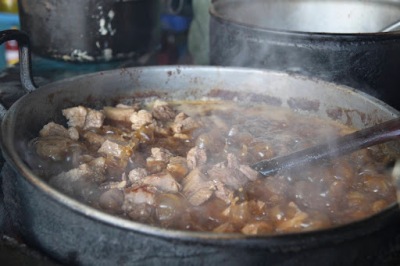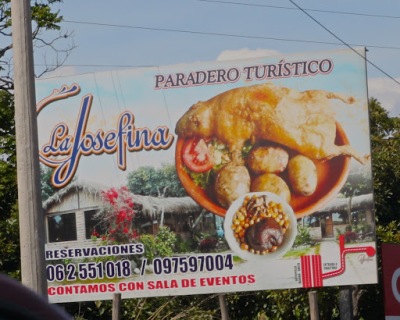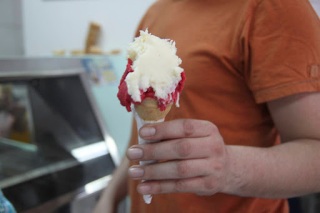To read more about my trip to Ecuador, check out these posts: One, Two, and Three.
The amazing food we ate in Ecuador deserves its own post… so here it is.
We began our edible adventures on a day trip from Quito to Ibarra. Fittingly, breakfast was first. I didn’t get any pictures of the biscocho cookies that we dunked in dulce de leche. But here you can see queso de hoja, fresh stringy cheese that’s pulled apart and eaten with your fingers. It’s saltier, tangier, and much more flavorful than the Polly-O sticks I loved as a kid.
After a long morning of navigating winding mountain roads, we stopped for lunch at a roadside restaurant further north. This was my introduction to fritadas. Fritadas are chunks of pork that are boiled, then deep-fried. They are incredibly delicious and decadent beyond belief. The outside of the pork, crispy from frying, yields to a tender interior that melts in your mouth. While fritadas are boiled with onions and spices, intense porkiness is the only flavor you’ll notice or need.
We also sampled choclo. I grew up in South Jersey and spent my summers eating farm-fresh corn on the cob. If you have a similar background, choclo will be familiar. The corn, a large-kerneled Andean variety, is boiled and eaten off the cob with fresh cheese. It’s milder than North American versions, and not quite as sweet, but unmistakably still corn.
 |
| Fritadas getting tender |
 |
| The table: choclo, cerveza, fritada |
 |
| Open kitchen |
Our next stop was for more fritadas, this time in Ibarra. We devoured more fritadas, tiny whole boiled potatoes, and a concoction called llapingacho that might have been my favorite bite of the whole day. Mashed potatoes are formed into patties around fresh cheese, then cooked on the griddle. If you like cheese fries, you’d love llapingacho.
 |
| Potato, fritada, fried choclo |
 |
| Llapingacho |
We were stuffed close to bursting at this point, but we stopped for ice cream anyway, because there’s always room for ice cream. Especially when that ice cream is helado de paila, a specialty not just of Ecuador but the city of Ibarra.
You can see my cone below: a mix of moro and coco, or blackberry and coconut. Stealing bites from other people’s cones, I tried guanabana, leche, frutilla, tamarindo, and taxo flavors. Everything was unfamiliar, fruity, and wonderful.
 |
| Pailas |
Anyway. Fried trout! French fries! An ensalada of the freshest, juiciest tomatoes! Rice! And to squeeze over everything, lime that wasn’t pale green inside, but golden orange. It was a delicious lunch. I ate so much that I could only try a few bites of Xavier’s food, the other specialty of the restaurant. Beef pounded thin, breaded, and fried, it tasted like an Ecuadorian response to wienerschnitzel. Times like these make me wish we really were what we eat. Like a cow, I’d love to have four stomachs to hold as many lunches.
Our last big meal in Ecuador was ceviche. We had driven past this place nearly every day that we’d been staying in Cumbaya, so I was excited to finally try it. Plus, seafood is my absolute favorite food, so that was a bonus.
It was a beautiful day to sit outside and feast. Our appetizer arrived first: a plate of assorted fried things: fish chunks, shrimp, and calamari. For dipping was a sweet and spicy aioli-type sauce served in a hollowed-out tomato. Cute and delicious.
The ceviches were pretty good as well. We ordered cangrejo, or crab, and camaron, also known as shrimp. I’d always thought that ceviche was raw fish in lime juice. But Ecuadorian ceviches are usually made with pre-cooked seafood. Because they don’t rely on acidic ingredients to “cook” the shrimp, these varieties are tomato-based and sweet. The briny, tender crab was a hands-down favorite, although the shrimp was great too.
Now that we’re home, I have plenty of ideas for bringing Ecuadorian food into our Atlanta kitchen. Keep your eyes peeled for locro, or potato-cheese soup, coming your way soon.















